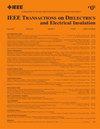A Practice of Sensory Cooperation for Insulation Diagnosis of Electrical Apparatus: Probabilistic Identification and Risk Assessment
IF 2.9
3区 工程技术
Q2 ENGINEERING, ELECTRICAL & ELECTRONIC
IEEE Transactions on Dielectrics and Electrical Insulation
Pub Date : 2024-12-11
DOI:10.1109/TDEI.2024.3515920
引用次数: 0
Abstract
In this study, a set of algorithms is tailored to achieve insulation defect probability identification and risk assessment based on multiphysical detections of partial discharges (PDs). Initially, three types of PD detection units are integrated into the flange to achieve a relatively uniform detection distance. Also, the synchronous PD detection platform is constructed based on intelligent sensor units, achieving extraction of sequential PD impulse information. Then, the multiphysics energy release power (ERP) is extrapolated based on the amplitude of the measurement signal amplitude. Also, three ERP values are normalized to analyze the proportional relationship of energy releases at different stages of discharge, which is further mapped in a ternary power pattern. In addition, we develop a probability recognition model based on the ternary error-correcting output coding (ECOC) united with a support vector machine (SVM). Meanwhile, by introducing discharge data of the same type with different defect scales, it can be verified that the proposed model possesses significant robustness. Besides, Gaussian process regression (GPR) is applied to fit the relationship between the ternary power pattern and apparent discharge energy (ADE). Also, the risk index and risk level are defined based on the temporal information of ADE during the entire discharge process, which is incorporated with the pulse repetition rate to achieve the visualization of discharge risk assessment.电气设备绝缘诊断的感官合作实践:概率识别与风险评估
在本研究中,针对局部放电(pd)的多物理点检测,定制了一套算法来实现绝缘缺陷概率识别和风险评估。最初,在法兰中集成了三种PD检测单元,以实现相对均匀的检测距离。构建了基于智能传感器单元的同步PD检测平台,实现了连续PD脉冲信息的提取。然后,根据测量信号的幅值外推多物理场能量释放功率(ERP)。同时,对三个ERP值进行归一化,分析不同放电阶段能量释放的比例关系,并将其映射为三元功率模式。此外,我们建立了一个基于三元纠错输出编码(ECOC)和支持向量机(SVM)的概率识别模型。同时,通过引入不同缺陷尺度的同类型放电数据,验证了所提模型具有显著的鲁棒性。此外,采用高斯过程回归(GPR)拟合三元功率图与视在放电能量(ADE)之间的关系。根据整个放电过程中ADE的时间信息定义风险指数和风险等级,并与脉冲重复率相结合,实现放电风险评估的可视化。
本文章由计算机程序翻译,如有差异,请以英文原文为准。
求助全文
约1分钟内获得全文
求助全文
来源期刊
CiteScore
6.00
自引率
22.60%
发文量
309
审稿时长
5.2 months
期刊介绍:
Topics that are concerned with dielectric phenomena and measurements, with development and characterization of gaseous, vacuum, liquid and solid electrical insulating materials and systems; and with utilization of these materials in circuits and systems under condition of use.

 求助内容:
求助内容: 应助结果提醒方式:
应助结果提醒方式:


